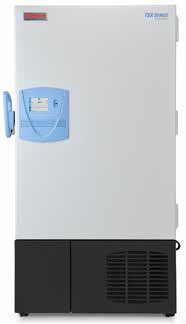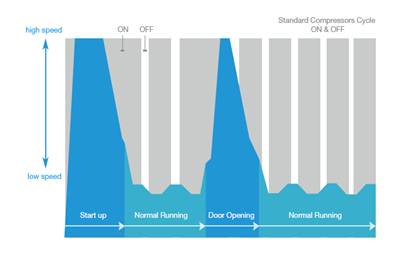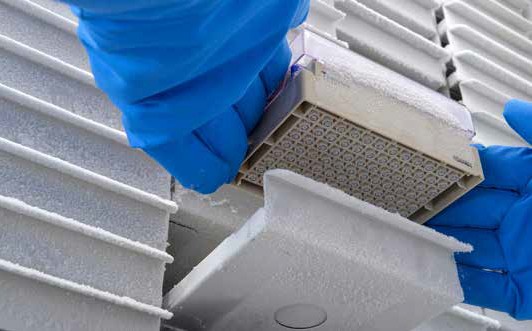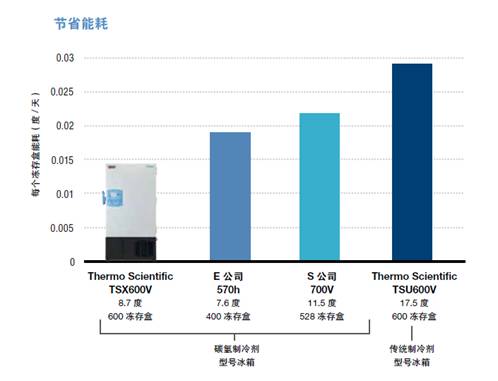Thermo ScientificTM TSX Series Variable Frequency Ultra Low Temperature Refrigerator White Paper
-- Best sample protection, lowest energy consumption
The laboratory samples are invaluable, not only for the fruitful results you have achieved, but also for your future work. Therefore, the laboratory relies heavily on freezing equipment that can reach -80 ° C ultra-low temperature to store samples to reduce biochemical activity in the sample and maintain its structural integrity, so that the sample remains active after thawing.
 Stable operation, rapid temperature recovery
Stable operation, rapid temperature recovery The commonly used ultra-low temperature refrigerator will be opened many times during the day's work, and the user can conveniently access the sample. Any opening event will result in a heat load on the refrigerator. The refrigerator should then start working as soon as possible to maintain a stable temperature inside the cabinet to avoid any potential sample damage. This recovery period consumes a lot of energy, and the compressor will run at full power to compensate for the temperature rise.
In the case of a heat load in a refrigerator, the ability to achieve a uniform stable set temperature within the cabinet is determined by the reserve capacity of the average British thermal unit (BTU). A refrigerator with a low BTU reserve capacity consumes less energy than a refrigerator with a high BTU reserve capacity, however it takes longer to eliminate the heat load return temperature. Designed to overcome this challenge, the Thermo Scientific TSX Series ultra-low temperature freezer features a unique V-drive technology.
V-drive technology allows the compressor of the TSX refrigerator to operate at variable speeds according to actual conditions, while the conventional compressor is forced to cycle and start. V-drive technology allows the refrigerator to automatically adjust the BTU reserve capacity based on the current thermal load, ie the compressor does not have to be forced to full power start when the door is opened.
In stable conditions, such as weekends and nights, the V-drive compressor maintains a low speed operation rather than a complete stop, and it can also quickly return to temperature when needed while saving energy. (Figure 1). Thus, the TSX frequency Ultralow freezer to warm quickly (e.g. 60 seconds to open the door only to warm quickly in 24 minutes, whereas conventional refrigerant refrigerator 50 minutes long),
an energy efficient. Compressor
Variable Frequency Drive combined with automatic control can effectively optimize compressor operating speed and save energy.
 Figure 1 Unlike the periodic start and stop of a conventional compressor, the V-drive compressor adjusts the compressor speed according to the current situation, such as the new machine starts and the compressor speed increases when the door is opened. Under normal conditions when the door is closed, the compressor operates at a low speed to maintain the set temperature value.
Figure 1 Unlike the periodic start and stop of a conventional compressor, the V-drive compressor adjusts the compressor speed according to the current situation, such as the new machine starts and the compressor speed increases when the door is opened. Under normal conditions when the door is closed, the compressor operates at a low speed to maintain the set temperature value. In addition to being able to quickly warm up during thermal loads, the TSX Series ultra-low temperature refrigerators provide you with an extremely high level of temperature uniformity, maintaining a stable internal temperature and reducing the energy consumption of your refrigerator. In high performance mode, the temperature deviation difference across the entire enclosure is less than 6 ° C, and the difference from the external display is less than 2 ° C. This difference in accuracy is very important in applications where temperature thermal control is critical.
Magical refrigerant
In addition to the mechanical impact of ultra-low temperature refrigerators, the choice of chemical refrigerants has a direct impact, especially in terms of efficiency and potential environmental impact. In the mid-1990s, chlorofluorocarbon (CFC) refrigerants were widely used in the commercial sector. CFCs, commonly known as Freon, are initially very effective refrigerants with low toxicity, low reactivity and low flammability. However, it was also found to have serious destructive effects on the ozone layer. The 1990 Montreal Protocol called for the reduction and discontinuation of CFCs as refrigerants, which was completely discontinued in 2000. The use of HFCs as an alternative refrigerant has gradually changed, but HFCs, which were initially considered to be superior to CFCs, also have a destructive effect on the ozone layer and still exhibit a significant global warming trend (GWP).
In recent years, manufacturers of ultra-low temperature refrigerators have turned their attention to natural hydrocarbon refrigerants. Hydrocarbons have very good thermodynamic properties and have proven to be very effective refrigerants with low GWP and no damage to the ozone layer. While many hydrocarbons are flammable, but many international, regional and national standards are in place to standardize and minimize this risk, and to inform the seller, the use of the product has been fully tested 4. Thermo Scientific TSX Series refrigerators use this natural refrigerant as a design principle to help customers use the safest products and inform customers of their details.
Heat exchange
The heat exchanger system for ultra-low temperature refrigerators is critical to the efficiency of the entire cabinet. Most ultra-low temperature refrigerators, including Thermo Scientific TSX series refrigerators, use a direct heat exchange mechanism. The expanded cryogenic refrigerant flows through a copper tube evaporator wrapped around the outside of the refrigerator, exchanges heat with the interior of the refrigerator, removes heat, and cools the sample.
The other is the mechanism of indirect heat exchange, which additionally requires intermediate liquid for heat conduction, which is cooled as a second refrigerant in the evaporator and then pushed into the heat exchanger (similar to an air conditioning system in a building, where cold water is distributed in the air cooler) ).
The Thermo Scientific TSX Series ultra-low temperature freezer uses a direct cooling mechanism that allows the refrigeration system to operate efficiently, allowing for rapid temperature recovery when opening the door and adding new samples to increase thermal load.

Highly compliant
Ultra-low temperature refrigerators not only have many components, but also have complex refrigeration technology; and the samples stored in them have higher intrinsic value, so it is important for users to know whether the equipment they use meets the specifications and standards. Most refrigerators now have an intuitive logo for viewing. The most famous of these are the CE and UL standards, and the Thermo Scientific TSX series of refrigerators meet both standards.
The letter CE appears on a range of products sold in the European Economic Area, and the CE mark is a self-declaration.
· Indicates that the manufacturer has confirmed that these products meet EU safety, hygiene and environmental requirements
· Indicates that the product meets EU regulatory requirements
· This product allows freely traded manufacturers in the European market to have paper documents to support product compliance. Once the product is found to be non-compliant, the CE mark may be revoked.
The letter UL indicates that the Underwriters Laboratories have tested the product and successfully determined that it meets UL's requirements. UL is a US global consulting firm authorized by the US Occupational Safety and Health Administration (OSHA) for safety testing. The presence of the UL Mark on the product and its complete components indicates compliance with factory and field installation requirements. In addition, the Underwriters Laboratories conduct periodic reviews to ensure that they continue to comply with the standards.
Environmentally friendly and cost effective
Fortunately, sustainable, environmentally friendly solutions are increasingly the focus of many scientific manufacturing industries. It is rapidly becoming a recognized standard, equipment manufacturing should minimize the impact on the environment, and the final equipment should be low-energy, cost-effective.
The innovative design of the TSX ultra-low temperature refrigerator combined with the unique technology V-drive makes it more energy efficient than the traditional refrigerators currently in use. The TSX refrigerator has been tested to use less than 0.015 kWh per day for each cryostat, which is 50% less energy than conventional refrigerant refrigerators (Figure 2). In the course of one year, the TSX refrigerator is expected to cost 3175.5 kWh, while the traditional refrigerant refrigerator requires an average of 6570 kWh 5 .
Saving energy also means cost savings (Figure 3), and therefore TSX600V in 10 years time can save up to US $ 4412.85 6.
 Figure 2 Energy saving of each frozen box in several popular refrigerators on the market
Figure 2 Energy saving of each frozen box in several popular refrigerators on the market  Figure 3 A one-year cost calculation for a frozen storage box. Calculated according to the energy consumption data released by each manufacturer on February 26, 2015 and 0.12 Euro per kWh
Figure 3 A one-year cost calculation for a frozen storage box. Calculated according to the energy consumption data released by each manufacturer on February 26, 2015 and 0.12 Euro per kWh Thermo Fisher Scientific understands the need for sustainable technology and adopts a green approach in plants that produce ultra-low temperature refrigerators. For example, we changed the water foam insulation layer to avoid the release of refrigerant gas which is easy to occur in other common foams. Our TSX ultra-low temperature refrigerators are award-winning, zero-waste landfill emissions, supporting 93% recycling and 7% waste conversion to energy.
More information on sample storage
The Thermo Scientific TSX ultra-low temperature refrigerator uses V-drive technology to quickly warm up after opening and dropping samples, reducing temperature fluctuations and ensuring that your stored samples are safe and reliable. It goes beyond simple reliability and provides customers with environmentally friendly, modern, sustainable low-energy equipment that is the best choice for safe sample storage.
For more information on the Thermo Fisher Scientific and TSX series of ultra-low temperature refrigerators, please visit:
references
1.Data on file. Thermo Scientific TSX600V tested compared to TSU600V data with highperformance mode.
2.UNEP, 1990. Montreal Protocol on Substances that Deplete the Ozone Layer - Article 2A: CFCs, Availableat: http://ozone.unep.org/en/Treaties/hb_treaties_decisions-fbb.php?sec_id=5.
3.Velders, GJM et al., 2012. Preserving Montreal Protocol Climate Benefits by Limiting HFCs. Science, 335(6071), pp.922–923.
4.BRA, 2012. Preserving Montreal Protocol Climate Benefits by Limiting HFCs, Available at: https:// Guide to Flammable Refrigerants - Issue 1 - Oct 12.pdf.
5.Calculated based on manufacturer published energy consumption data as of 2/26/2015 and energy cost assumption of 0.12 euros / kWh. Energy consumption is based on manufacturer published energy consumption data as of 2/26/2015. Data on fi le. Thermo Scientific TSU600V data with high-performance mode.
6.Calculated using data from the European Commission's published electricity and natural gas price statistics. http://ec.europa.eu/eurostat/statistics-explained/index.php/Electricity_and_natural_gas_price_statistics.AccessedMarch, 2015.

 Stable operation, rapid temperature recovery
Stable operation, rapid temperature recovery 




